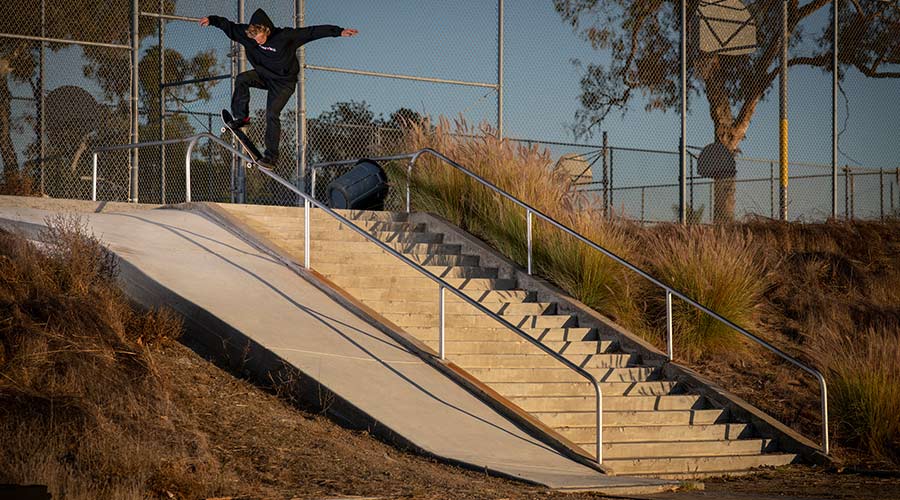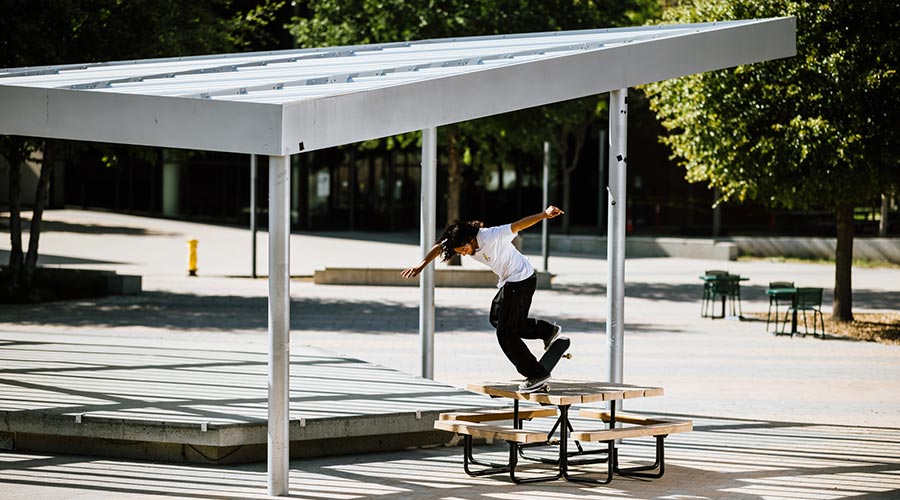How to Choose the Right Skate Shoes

Choosing a skate shoe can be a little daunting. Not only do a ton of different brands make skate shoes, but they all also make different styles, utilizing different materials and technologies. While finding the right skate shoe is largely a personal choice, there are important things to note when making a decision.
Here’s what you need to know when shopping for new skate shoes.
What Makes A Skate Shoe?
While there are many “skate-style shoes” on the market, not all of them are designed for skateboarding. It’s safe to say they are inspired by skateboarding but not designed for it. A true skate shoe will have key design features and materials to make the shoe feel more natural and last longer when skateboarding.
Let’s look at what makes up a skate shoe.
Grip Pattern
Since most skate shoes have flat outsoles, it is important to have a grip pattern that is basic and consistent. This ensures that your shoe will hold better to the grip tape.
Heel Cushioning
The heel cushioning is one of the most vital components of a skate shoe. Heels directly absorb most of the impact when landing—on or off the board. Heel bruises can occur when you bail a trick or land on your board in the wrong position. Simply put, you want a skate shoe to have a generous amount of heel cushioning, without being so large that you can’t feel the board under your feet.
Toe Cap
Toe caps can lengthen the lifespan of any skate shoe because the toe usually wears out first—especially for skaters who do a lot of flip tricks. Rubber toe caps are not only great because they make your shoe last longer, but they also provide grip which makes your board more responsive when doing flip tricks. Some shoes also have a high abrasion coating in the toe cap area. This is a lighter form of protection, but it is nice because there are no seams or stitches in this vital area.
Collar
The collar is the padding around the ankle of a skate shoe. Thicker padding will hold your heel down and prevent foot slippage. It also gives your ankles a little more protection from being hit by the skateboard. Your skateboard will always be landing on your feet and banging into your ankles while trying tricks, so this can be very important. That being said, some skaters prefer to skate a slimmed-down shoe with virtually no collar padding. It’s largely a matter of style and personal preference.
Lace Protection
Some skate shoes have protective lace loops while others have more traditional eyelets. For instance, “Ghillie” lace loops protect laces where they are the most vulnerable. That being said, some skaters will still tear through several laces in every shoe.
Stitching
Having reinforced or hidden stitches in key areas is very important. There are certain areas on the upper of a skate shoe that grip tape rubs more often. However, the exact area varies from skater to skater, as everyone has unique styles and techniques.
The Different Skate Shoes Styles

Slip-Ons
Slip-on skate shoes are convenient because you don’t need to worry about torn laces or weak points in the stitching. Generally, slip-ons have slimmer silhouettes with less protection. But, if you find a slip-on shoe with a rubber toe cap, it can last quite a long time.
.jpg)
Low Tops
Most skate shoes are low tops. They allow a full range of motion in your ankles and keep your feet cool. The only drawback to low-top skate shoes is that they don’t protect your ankle.

Mid Tops
Mid tops are a great option for skaters who want a little higher ankle protection but without too much-added weight or bulk.

High Tops
Skaters like high tops because of the style and all the protection they provide around that sensitive, often banged-up ankle area. Of course, they take longer to get on and off, and are warmer than low or mid-top shoes.

Puffy
Puffy skate shoes are very popular right now. Many skaters love the nostalgia of 90s-style skate shoes, but they also love the way they feel when skating. Puffy skate shoes offer more padding and protection. In some cases, they have more technical upper designs that last longer.
Slim
Slimmed-down skate shoes will always be popular because they are so accessible. They are usually more affordable with straightforward upper designs. While they might not offer as much ankle and forefoot padding, some skaters like the improved board feel. When buying a slim skate shoe, make sure it is designed for skating with durable materials, a strong rubber outsole and a comfy insole.
SHOP MEN'S SKATE SHOES SHOP WOMEN'S SKATE SHOESSkate Shoe Soles
Insole
Most skate shoes have removable insoles. A thicker insole provides more impact protection and can reduce the stress on your heels, legs and even back. The bottom of your feet can take a beating from all the jumping and landing on hard surfaces while skating. But, if your insoles are too thick, you won’t be able to feel your board very well. This can make it harder to learn tricks. So, a strong and relatively thick insole is perfect for most skaters.
Midsole
The midsole sits below the insole and above the outsole. Even though neither your feet nor board touch the midsole, it is an important component when it comes to impact protection and board feel. That is, a shoe with a super thick midsole might give you a lot of impact protection, but it could also be clunky and heavy. Note that midsoles only exist on cup sole shoes.
Outsole
The outsole is super important because it is the surface that comes in with your board and rubs against the grip tape as you do tricks. Since grip tape is so coarse and destructive, having a thick and grippy rubber compound is essential. The good thing about a thick outsole is that it will last longer. But, thicker outsoles are also heavier, and less flexible, and they take longer to break in. So, it is all about finding that happy medium.
Sole Types: Vulcanized Soles vs. Cupsoles
The debate between vulcanized and cup sole skate shoes is as old as skating itself. Both styles are manufactured in different ways, and this can affect how they skate. Both technologies have advanced so much in recent years that either option offers top-of-the-line performance, but there are small differences worth discussing.
Vulcanized

A vulcanized shoe is made out of two pieces of rubber. The shoes are made by glueing the upper to the rubber sole, and then the foxing rubber is wrapped around the shoe.
Vulcanized soles usually have a more classic, simplistic look. The vulcanization heat process creates a sturdy, no-nonsense outsole. In the past, some skaters steered away from vulc because they thought it was too heavy and/or too thin. But modern vulcanization techniques create lightweight and high-performance outsoles that are ideal for skating. While technical skaters usually choose a cupsole shoe, many are now opting for vulcanized soles.
Benefits:
- Thin, light and flexible
- Good board feel
- Easy to break in
Cupsole

Cupsole shoes are very much on the upswing right now. Cupsoles are made out of one piece of rubber formed in a mould. In general, cupsoles lend themselves more naturally to technical designs that provide better impact protection. Often, shoes with more complicated, tech-focused uppers will also have cupsoles.
Many skaters love that the cupsoles usually have a more intuitive fit and additional cushioning, especially at the heel. Also, cupsoles are made from just one piece of rubber for extra durability, so there is no risk of two pieces of rubber separating from each other (as there is with vulcanized shoes).
Benefits:
- Durable
- Impact Protection
- Heel Support
Upper Materials
The upper material is key to the durability of any skate shoe. For most skaters, the upper will tear or be worn through by the grip tape before the rubber outsole wears out. This is why you often see skaters with large holes in their shoes exposing their socks. If you want the longest-lasting shoe, it’s important to choose skate shoes with the right upper material.

Suede
Suede is the most common upper material in skate shoes because it is durable, affordable and lightweight. Importantly, suede also has the ideal texture for skateboarding—not too grippy and smooth. This is perfect for learning tricks and important for skaters who do a lot of flip tricks.

Leather
Leather is another great option that performs similarly to suede. But, since leather is more expensive, it isn’t quite as common.

Vegan Materials
More and more brands are starting to look for eco-friendly and vegan options for skate shoes. In general, vegan leathers and suedes are still rare, but you can expect to see more and more in the coming years.
Canvas
Although canvas isn’t traditionally the longest-lasting material, skaters like that it is light, flexible, breathable, and affordable.
How Should Skate Shoes Fit?
Your skate shoes should fit snug and secure. That being said, you don’t want your toe to be touching the end of your shoe. When you skate and try tricks—especially when you don’t land on the board—your foot will slide forward. If your shoes are too tight, it's going to be painful on your toes. So having a little bit of wiggle room—even if it’s just a ¼”—can save you a lot of discomforts.
It is also important to note that skating will cause your shoes to wear in quite quickly. Since skate shoes are usually constructed with reinforced fabrics and heavier-duty rubber, they might seem stiff at first. But even if a shoe doesn’t feel 100% comfortable when you first try it on, skating will help it stretch out and become more flexible in all the right places.
Wide Feet
Choose styles with contoured arch support, and a rounded or square-shaped toe wrap.
Your best bet may be mid-tops and high-tops.
Narrow Feet
Go for shoes that are longer, and slimmer with heel support.
Styles like low tops may be a good option.
Flat Feet
Shoes with insoles that provide solid arch support are key.
EVA insoles are a popular option because they provide excellent shock absorption and comfort.
What Shoes are Good for Skateboarding?

While it is important to choose shoes that are designed for skateboarding, there is no right or wrong shoe for any one person. Some skaters only wear vulcanized shoes, while others are loyal to cupsoles. Some like puffy shoes with more padding, others like thinner, deconstructed styles. In the end, it comes down to personal experience, preference and skateboarding style.
Street /Transition Skateboarding
Vulcs are an excellent option for skaters that want to cruise around the streets, practice flip tricks, and skate transitions. These shoes provide good flexibility and board feel. Choose vulcs made from durable upper materials like suede, leather, or synthetic materials. If you need ankle protection, mid-tops are a solid choice.
Skating Gaps
If you need solid impact protection from skating large gaps and stairs, having shoes with thicker insoles is very important. Cupsoles usually have more padding under foot—compared to vulcs—because the rubber is thicker. But, you can now find modern vulcs that make up the difference because they come with nice, thick insoles that provide great impact protection.
While you will sacrifice a little bit of board feel with more underfoot protection, you can prevent heel bruising and injuries as you step up to bigger obstacles.
Cruising
If you’re starting out or just cruising around town without ever trying tricks, your shoe choice is less consequential. Of course, having a shoe that you can also walk around in all day is nice. Canvas shoes are a good choice since they are lightweight and breathable. Just make sure the shoes have a nice grippy rubber outsole that will last long and stick to the grip tape.
